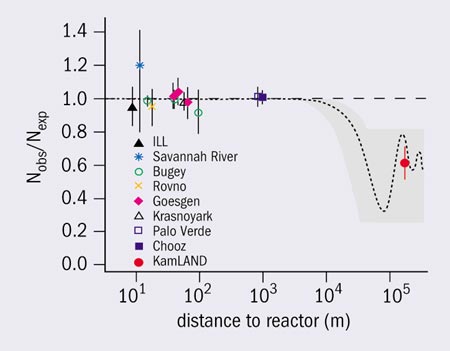
The first results from six months of data-taking by the KamLAND experiment in Japan indicate that electron antineutrinos from distant nuclear reactors are “disappearing” on their way to the detector. This is the first observation of such a disappearance in a reactor-based experiment. The results support evidence from solar neutrino experiments for neutrino oscillations, in which the electron neutrinos change into another type.
KamLAND, which consists primarily of a 13 m diameter “balloon” filled with liquid scintillator viewed by more than 1800 photomultiplier tubes, is located on Japan’s main island of Honshu, near the city of Toyama. It is exposed to electron antineutrinos emitted from some 51 nuclear reactors in Japan, plus 18 in South Korea, at a variety of distances. While experiments detecting solar neutrinos have for more than 30 years found fewer electron neutrinos reaching the Earth than expected, there has been no evidence for a similar effect in experiments studying neutrinos from nuclear reactors. However, the mounting evidence for oscillations from experiments with solar and atmospheric neutrinos show that in these experiments, the detectors were too close to the reactors to observe an effect. Now KamLAND has found a clear deficit in the number of electron antineutrinos arriving from an average distance of about 180 km.
KamLAND detects electron antineutrinos through the inverse beta-decay process, in which an electron antineutrino interacts with a proton to create a positron and a neutron. For data collected on 145.1 days between March and October 2002, the experiment recorded 54 electron antineutrino events in the energy range 1-10 MeV, as opposed to around 86 events predicted by the Standard Model, assuming that no oscillations occur. More precisely, the ratio of the number of observed inverse beta-decay events to the expected number (i.e. without disappearance) was found to be 0.611 ± 0.085 (stat) ± 0.041 (syst), for antineutrino energies greater than 3.4 MeV.

These results agree well with those of recent best-fit predictions of the large mixing angle (LMA) oscillation solutions, and indeed reduce the allowed LMA region for the oscillation parameters sin22θ and Δm2. The best fit to the KamLAND data in the physical region for the parameters gives sin22θ = 1.0 and Δm2 = 6.9 x 10-5 eV2. Further analysis with more data should reduce the errors and provide a higher precision measurement of these key parameters.





